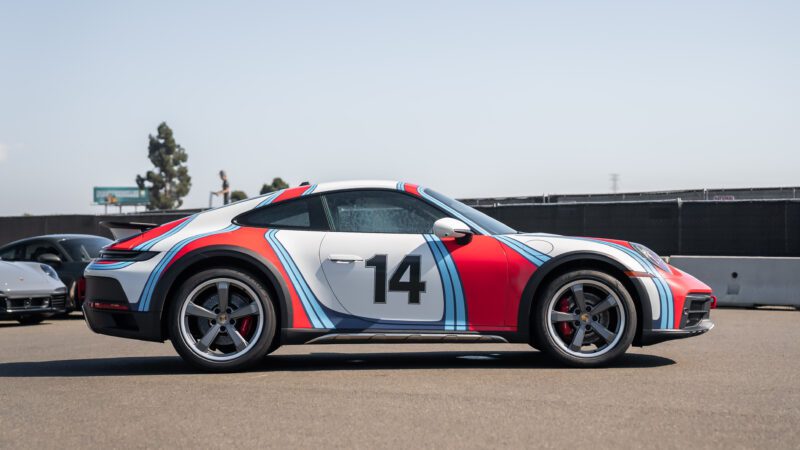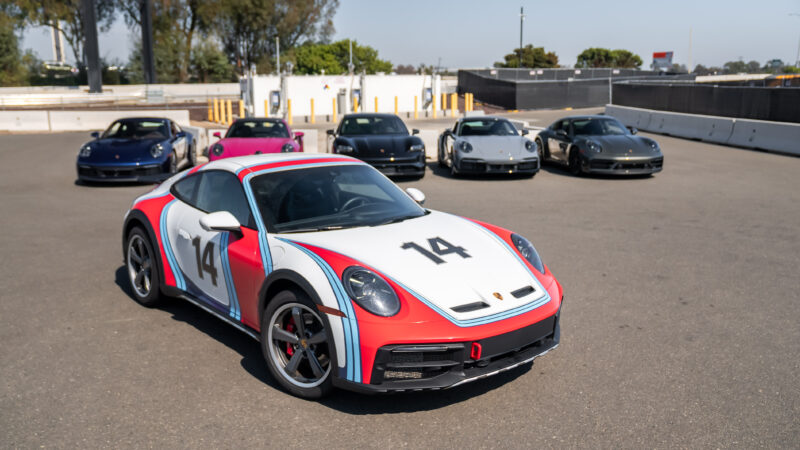
Porsche 911 Dakar Track Day
You couldn’t miss the
. The Porsche 911 Dakar is instantly recognizable thanks to its lifted stance, wider fenders and Fuchs style five-spoke wheel. This limited-production model, which started out as a Carrera 4 GTS and was developed from there, is even more appealing when it’s dressed in one of the available liveries. The limited production of 2,500 cars has sold out. Looking at the pre-owned market, you’ll find asking prices that are well above $300,000. You may ask, “Why bother driving this car?”. Like the rest of Porsche’s 911 range, The Dakar has a multi-faceted persona. In its marketing materials, it is shown in desolate locations or on sand dunes. However, in reality most of them will either be kept in collections or used to pound asphalt. Only a few Lamborghini Huracan Sterratos will be driven in the way they were intended. Its engineers didn’t build it to be a rigid off-roader. It’s still a Porsche, and it promises to perform just as well on trails as it does off-road.
I admit that I am pushing this to the extreme. When Porsche suggested that I drive the Dakar at its Experience Center, in Los Angeles, rather than on a street or carefully selected off-road track, I jumped at it. But there’s a reason for the madness. The Porsche Experience Center in Carson, CA is a large facility located less than 20 minutes away from Los Angeles International Airport. The Porsche Experience Center is one of two PECs located in the US. The first PEC opened in Atlanta, Georgia in Atlanta’s North American Headquarters. The marque offers a variety of driving experiences in LA. These range from a Cayenne to the GT3 RS. I’m in Dakar for the 90 minute session, which costs $1,025. Once you’ve checked in, the second floor of the building is filled with rows of classics preserved, a workshop of world-class, a cafe and a restaurant. There is plenty to see and do. After a quick cup of coffee, I went to the PEC staging area to meet the driving coach, who would be riding shotgun.
The Porsche 911 Dakar that I would be driving was parked amongst 718 Caymans and Tacans in all colors, sporting an optional Rally 1978 paint scheme, which pays homage to the 911 SC Group 4 Bjorn Waldegard used for the East African Safari Rally of 1978. The Porsche 911 Dakar is equipped with a sleek top that lacks a sunroof and any of the other accessories it can be fitted with. The staff at PEC wrapped the five-spoke wheels in Pirelli P Zero tires for the day. Porsche designed the Dakar as an off-roader before anything else. Although its options list offers sets of winter and summer as extras I wondered how much its driving experience would mirror that of the Carrera 4 GTS on which it is based. I sank into the standard carbon fiber bucket seats, fired up the flat-six engine and slowly crept out onto track.
The Porsche 911 Dakar experience may only be 90 minutes long but has a choose-your-own-adventure feel. The 1.3-mile handling track is the crown jewel of PEC. There are also low-friction tracks, a giant sprinkler-equipped skidpad, kick-plate exercises to test your reactions, and a circuit off-road. This is not a trackday, but a day for SUVs.
We started with some runs on the Kick Plate, which simulates hydroplaning at highway speeds by using a moving metal panel. This is a good test for your reaction time. If you move too slowly, you will complete the loop before you know what has happened. The all-wheel drive Dakar will recover from the initial slide with a simple twitch at the rear. The skidpad was the next challenge. The giant donut course was ready to slide with sprinklers falling on its surface. I was not. As I gained speed, I slowly let go of the accelerator while pointing the nose in the direction of the middle. I counter-steered and floored the throttle to catch the slide. It was exactly the same as what I had done on ice tracks with rear-drive V8 Maseratis and countless rear drive BMW M cars. I had forgotten that the Dakar was all-wheel drive.
It was easy to start, but holding the car was much harder. The Porsche 911 Dakar is able to maintain extreme angles while it slides sideways across a track. Once in a drift, you need to commit to the throttle completely to keep the car going. It demands constant power, even when you think you are a split-second away from looping. You’ll get controllable drifts if you grant its wish. It only takes a little mental rewiring. Before we drove the 1.3 mile circuit, my instructor took me on a short autocross to familiarize myself the Dakar’s performance on dry surfaces. It was only a matter of minutes before it was time to do some citing laps. The track experience begins from the right side of the seat, as the instructor takes you on a tour around the track. He points out the braking zones and shows the best racing line. You are now more aware of all the other cars that share the circuit. You may notice a GT4 RS sneaking up behind you or catching up to a Carrera on a cooling-down lap as you come out of a turn. The instructor will constantly monitor traffic to make sure everyone maintains their distance, and only passes in designated zones. In the carbon buckets I felt I had finally mastered the Dakar. Its cabin, GT sport wheel and excellent visibility are familiar, but there are some noticeable differences. One is its stance. The Porsche 911 Dakar is 1.9 inches higher than a Carrera with sports suspension. It is raised 1.2 inches by a standard lift system, and it will remain at this height until it crosses 105 mph.
Its hood, a gift from the GT3, and rear spoiler are carbon-fiber-reinforced plastic. The combination of lighter glass and a lighter lithium-ion battery allows it to weigh 3,552 pounds. This is 16 lb more than a 911 Carrera 4 GTS with a PDK. The Dakar is heavier than a 911 Carrera 4 GTS equipped with PDK, but it also has a new intake system and additional underbody protection. The oily bits are largely unchanged from the Carrera 4 GTS, and its twin turbocharged 3.0-liter six-cylinder engine produces the same 473 horsepower as well as 420 pound feet of torque. The car will reach 60 mph in 3.2 second and can top out at 149 mph. Power is sent to all four wheels by an eight-speed PDK. As I became more familiar with the 1.3 mile track, I found myself getting into a nice rhythm. It may surprise you, but the Dakar is a 911 when fitted with summer tires. The handling of the Dakar is still confident and, thanks to Pirelli tires, it has the grip that you would expect from a Carrera 4 GTS. It didn’t feel or lean in the corners as I would have liked, nor did it squat when shooting out the other side. The nose did not dip much under hard braking, and the rear didn’t squat when shooting out of the other side. Even though Porsche designed it for off-roading, I still can’t stop thinking about the places these cars live. It’s one thing to build a car that excels off-road, but it would lose its appeal if the vehicle only performed well in this environment. Dakar is unique in that it does not ask you to make a choice. It’s possible to have all the benefits that come with increased ground clearance: a smooth ride, the unique look, and a cool aesthetic, without having to sacrifice anything. It’s as versatile as any 911 should be, whether you take it off-roading, or to the track for whatever reason.


